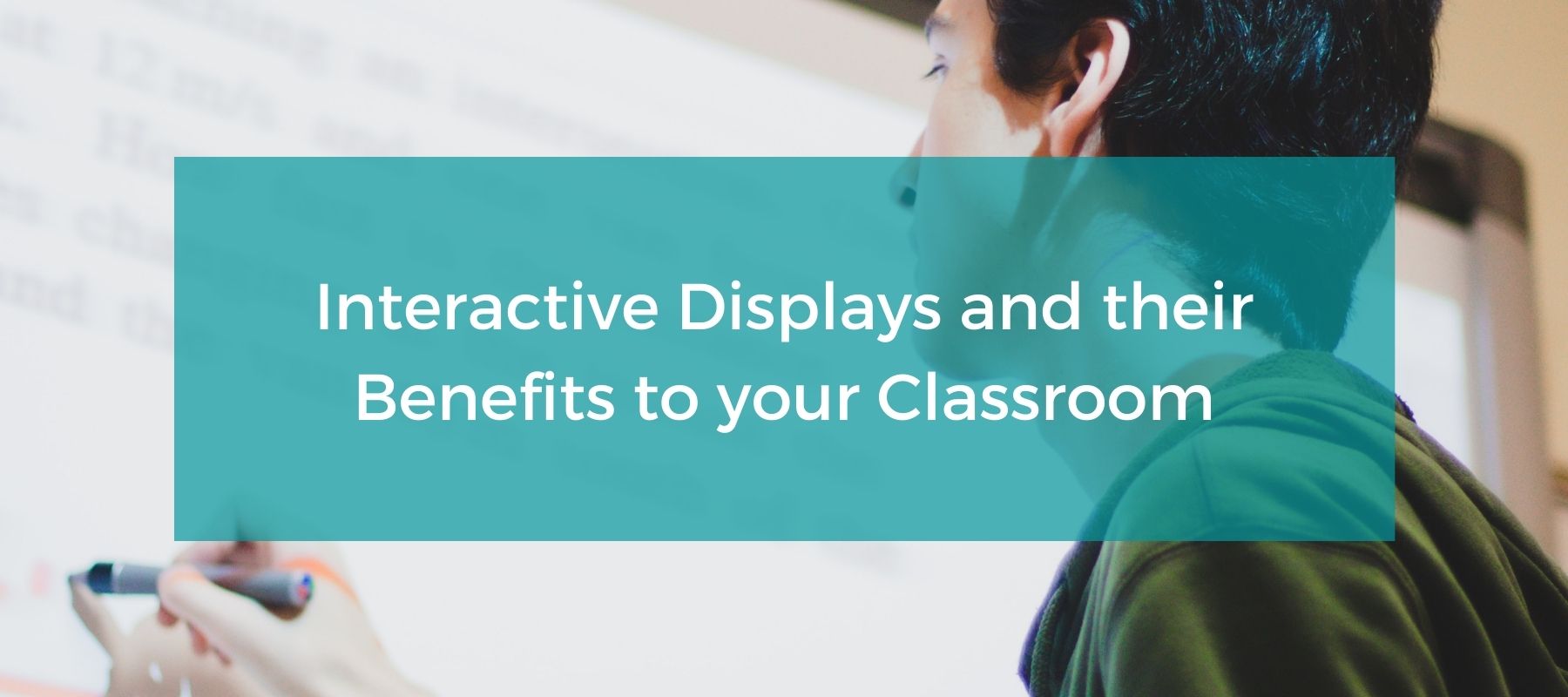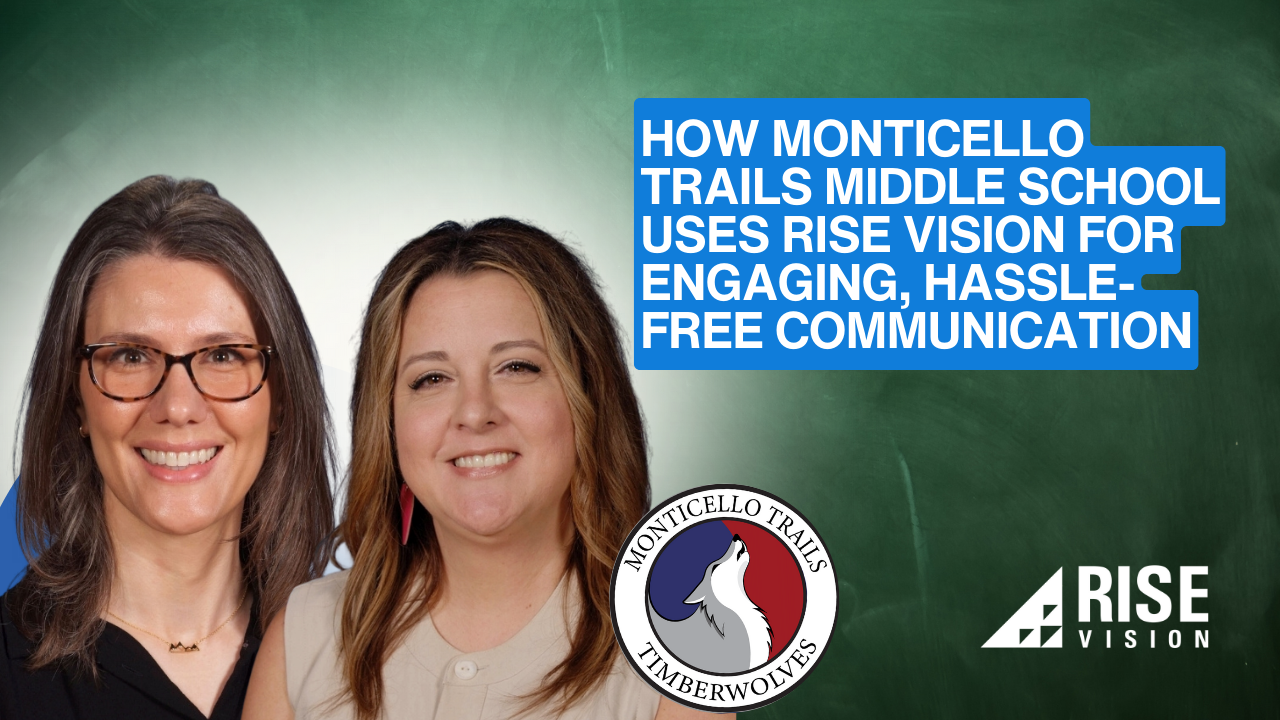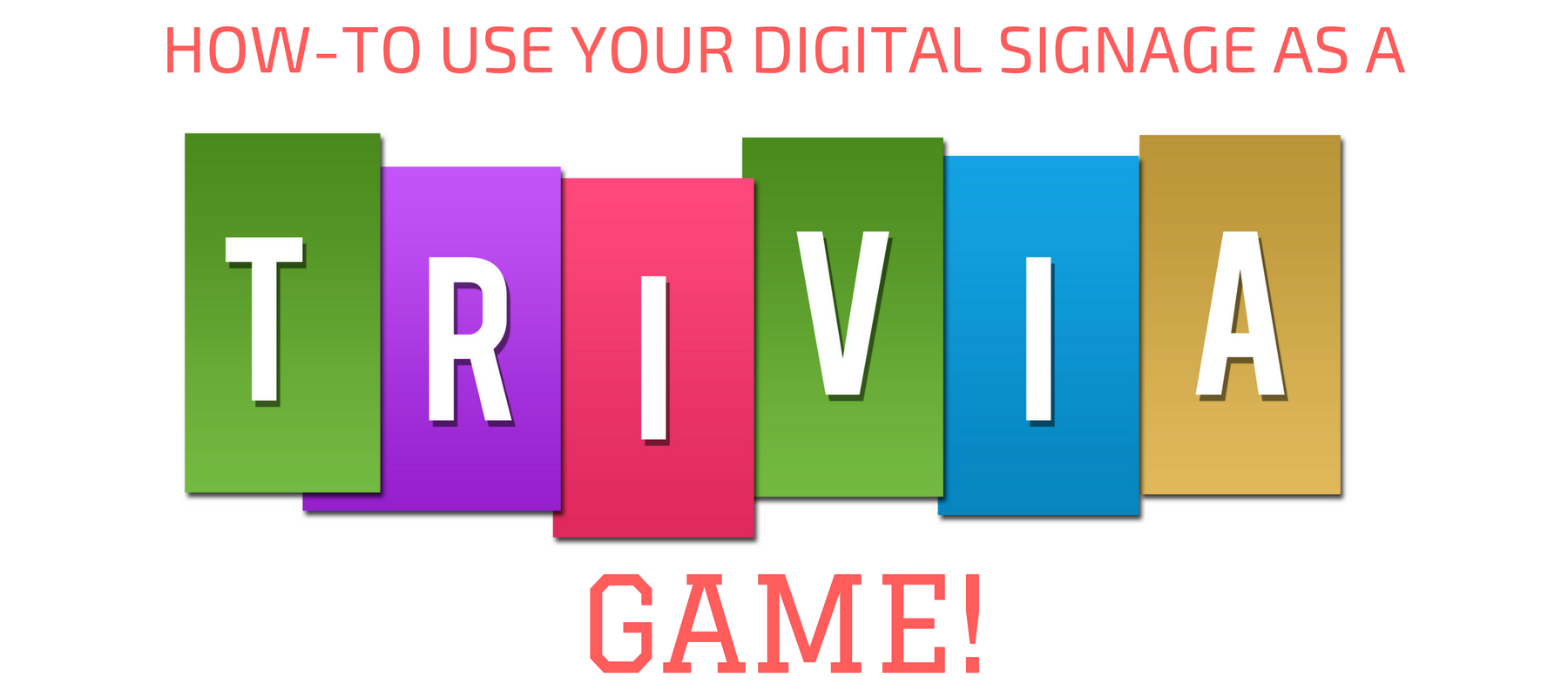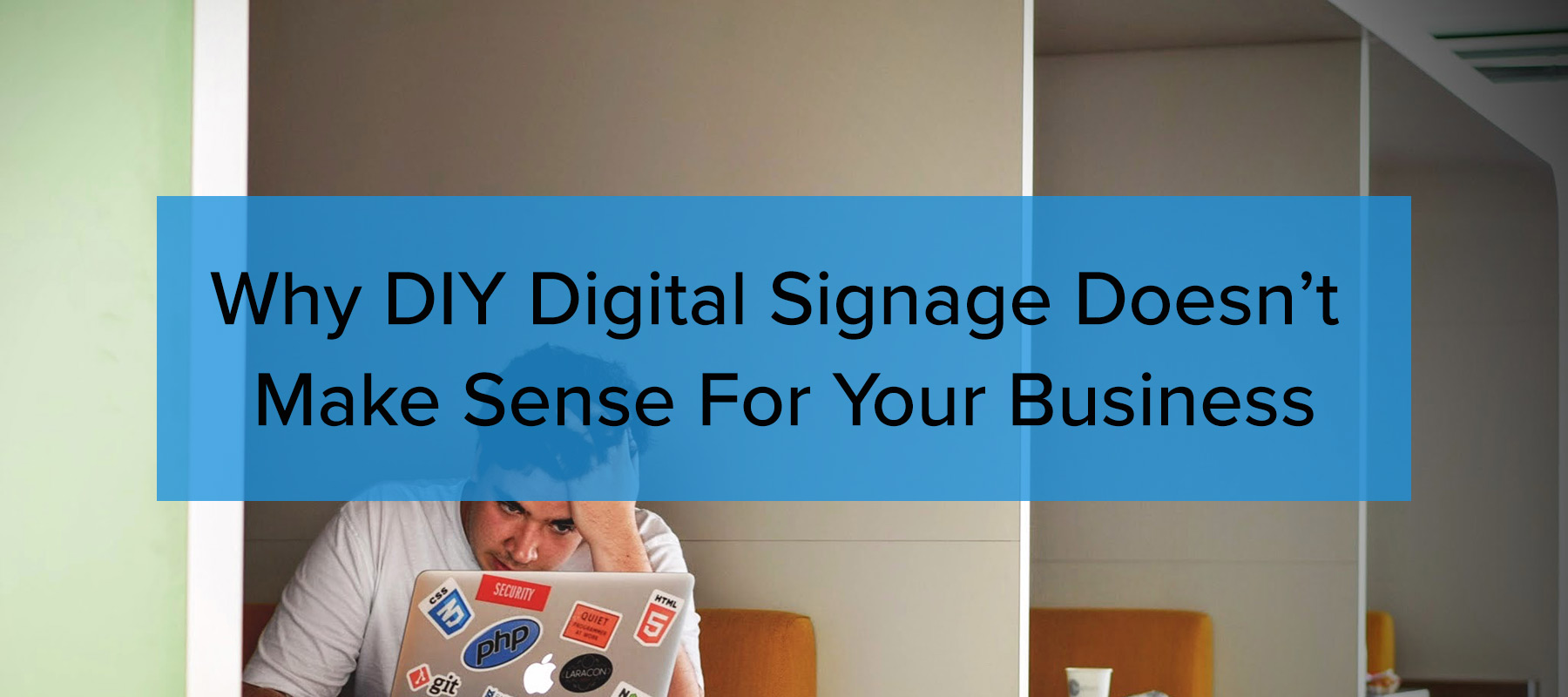
When you’re looking for a digital signage solution for your business, it’s tempting to think that building your own system will be easier and cheaper than buying a solution from outside. And it’s true that DIY systems typically involve lower initial outlay.
However, they also tie business owners and managers into an endless cycle of repair, maintenance and content management, required to make up for the initial shortfalls of the system. And DIY setups rarely deliver on the business promise of digital signage either. In nearly every case, it’s better to get a professionally-built digital signage system.
We’ll go over why that is, but first, briefly, let’s remind ourselves why digital signage is such a good idea in the first place.
Why digital signage?
Digital signs are versatile and adaptable. They can show new messaging when things change, and they’re more engaging and effective at communicating than static signage.
To learn more about the advantages of digital signage, check out this post.
What’s the difference between DIY and professional digital signage?
Professional digital signage solutions might be turnkey or they might involve a central software hub that can be integrated with other hardware options. Typically they’ll offer options for different users with different needs — a small church or local nonprofit has very different needs from a large school or a business with multiple franchises.
The key components of professional digital signage are:
CMS
The core of your business’ digital signage is the CMS. This lets you decide what all your signs show from a central location. A good digital signage CMS will let you:
Schedule content
You should be able to calendar content to change when appropriate — putting your Christmas content together in fall should be simple.
...across multiple displays...
Segment and plan different content for different screens. You should be able to create groups of screens and assign content to them, such as Lobby, Shop and Back Office, or grades at a school.
...using multiple media
A good CMS lets you build multimedia presentations. You don’t always have to, and you can go a long way with static image-and-text displays, but you should be able to animate presentations, embed video, add audio, and add live streams, social feeds and weather and other updates easily.
Media player
The other piece of the puzzle is the media player. This can be a software tool that runs on any device or on a group of operating systems, or it can be offered as a package including the software, the hardware to run it on, and sometimes compatible screens. Its job is to take the content you’ve built and scheduled in your CMS and transport it to your screens.
This means there are compatibility issues involved: the CMS, media player, underlying hardware, and screens all have to work with each other. That’s why many digital signage vendors offer packages in which they’ll deliver and install a complete working solution; that way their customers never have to worry about weak links in the chain, or having to replace all their screens so they’re compatible with the software they just bought.
To learn more about digital signage software, including the difference between cloud and onsite software, check out this post.
By contrast, DIY digital signage doesn’t offer any of this. It’s less well-defined by its very nature, but DIY digital signage can consist of just a TV set to play a DVD over and over, or a monitor playing content from a desktop computer over WiFi or LAN.
Other DIY efforts involve a CMS plugged into a selection of screen types, using a media player from another source and running on an inexpensive device like a Chromebook or Raspberry Pi.
Why do people choose DIY digital signage?
The main reason businesses choose DIY digital signage is cost. Integrated, central digital signage solutions are perceived as being expensive. This view is most common among smaller businesses that lack designated budgets and organized roles, though it’s also common among other organizations with similar structures, such as nonprofits and churches.
Another reason is the proliferation of digital signage solutions on the market. When the decision-maker at a business isn’t highly technically skilled, choosing between features and systems is confusing, worrying and exhausting. Rather than learn how to differentiate between good and bad software, people commonly look for a way to ‘cut out the middleman’ and build their own system.
What’s wrong with DIY digital signage?
Some DIY digital signage solutions are awesome. But like anything, a good digital signage setup takes skill, time and effort to build. Many companies don’t have the skills in-house, while for others budgetary considerations and time constraints abutt: they don’t have the time or the money to build their own digital signage, but they urgently need the improved business outcomes that well-executed digital signage can provide.
Here’s where DIY builds usually go wrong:
Tech selection and system design
Choosing the right tool for the job is a skill all by itself. When an organization tries to build its own digital signage solution, it comes to the problem cold. This is its first attempt. Companies that supply such solutions professionally have ample experience, and can match technology to goals and structure based on previous projects. They also know how to anticipate and avoid compatibility issues and stumbling-blocks to implementation.
One example, screen choice, makes the point:
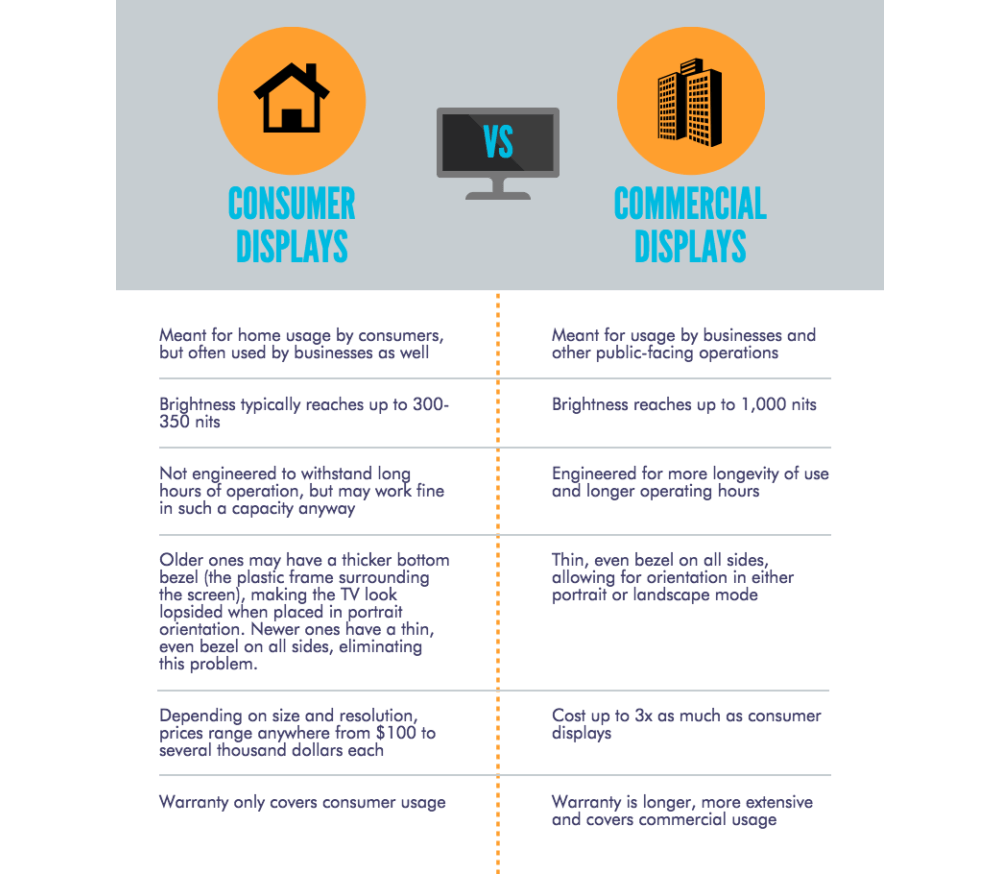
Maintenance and support
Once an organization acquires the components, builds its DIY solution and turns it on, what then? In any system with this many parts, there are going to be issues with software updates and deprecations, hardware maintenance and general system support and upkeep. But without the staff or expertise to do that, many businesses keep running a DIY solution even when it’s in poor repair and frequently underperforms or fails.
Scalability
One hallmark of a system that’s well-designed by a professional is that it’s easy to scale. DIY solutions often rely on ad-hoc methods — spreadsheets for calendared content, USB sticks or physical visits to screens — that can work OK when you just have two or three screens. What happens when you get a bigger premises, a franchise, or you find you need to expand your digital signage system? These inefficiencies can be minor irritations at one scale and a complete nightmare when your system gets larger.
Once they’re up and running, the biggest day-to-day issue is performance. DIY systems don’t perform as well even when they’re working as intended, and they often partially or wholly fail. Worse, it’s when you’re busiest that you need them most, and that they’re most likely to let you down.
Here’s where they most often go wrong in action:
Content quality
Forced to cut corners and make compromises simply to get content on the screen, many DIY solutions will be conspicuously less versatile and engaging than their professionally-created counterparts. Cutting CMS quality means you need to bring more content creation skills to the table, or spend more time creating your content. If you can’t, the results will be visibly worse. In addition, the functionality to display embedded third-party content, animation or simple design in content will be difficult to acquire and use. Your viewers will see this all too clearly.
Uptime
DIY systems crash more often. You’ll be showing Windows boot screens instead of the content you want. A poorly-designed, poorly-maintained digital signage system can actually perform worse than traditional static signage. And when your DIY system goes down, there’s no-one you can call to fix it. Your homebrew setup isn’t in anyone’s manual, and if you do opt for professional IT assistance, they’re going to have to spend hours figuring out how you put it all together in the first place before they even start fixing it.
DIY digital signage fails
What does digital signage look like when it goes wrong?
This shop display is using professional hardware to display a PDF on a desktop background:
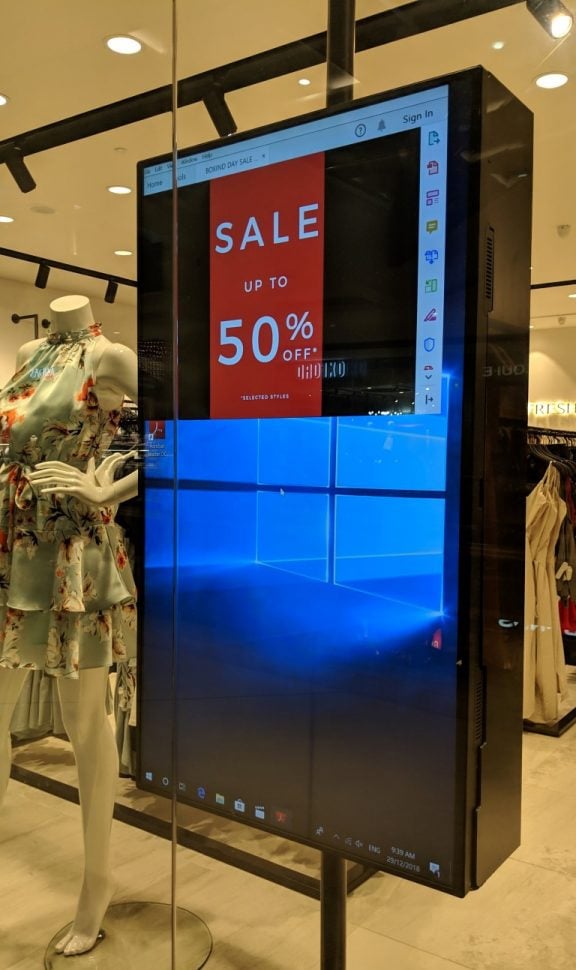
It’s not a low-cost display, but it looks poorly-organized and cheap, damaging the shop’s image.
In this instance, there is a digital signage content tool in use, it’s just not equal to the task.
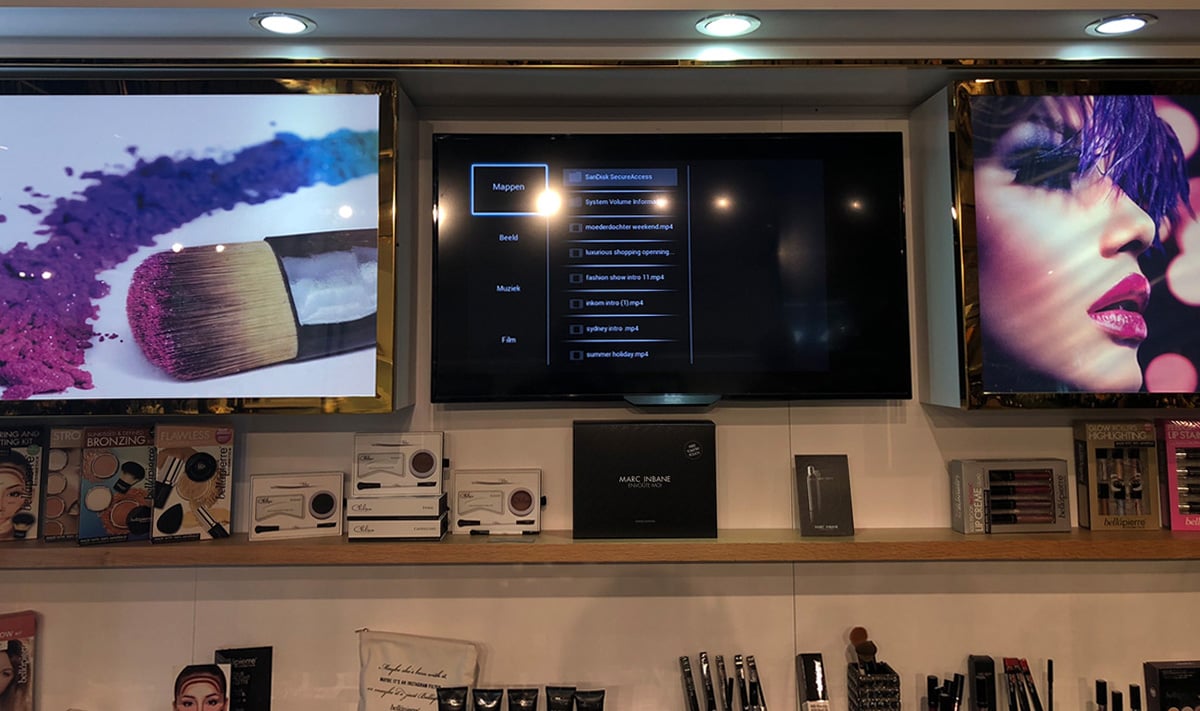
What should be all glamour and sophistication is instead the scheduling screen, waiting for someone to tell it to play.
In this case, there’s a Windows-based display OS whose network is not working out too well.
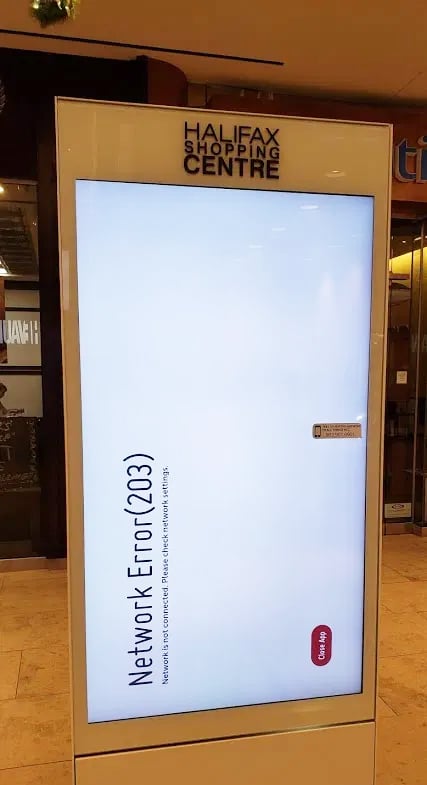
Professionally created and installed digital signage solutions do sometimes encounter glitches — but they’re more resilient, easier to fix, constructed from components designed for purpose and much less likely to let you down.
What should you do instead?
Professional digital signage releases you to focus on what you actually do: teach your students, create and sell your products, or reach your congregation. The legwork is done for you. Look for a solution featuring:
Media player recommendations or pre-installation
A professional digital signage provider will be able to recommend hardware to run their software on, and often offers ready-installed, plug-and-play combinations of hardware and software.
Rise Vision software is compatible with Windows and Linux Ubuntu (note, not with any other Linux builds). If you have a media player already selected and it runs either of these, you should be good to install Rise Vision software and get started. If not, there’s community support for Android, Chromebook, and Raspberry Pi through the Riseberry project. Technical specifications and more information is here, including advice on touchscreen solutions.
There’s also the Rise Vision Intel NUC Celeron Media Player (Linux), a pre-configured media player with Rise Vision already installed and checked:
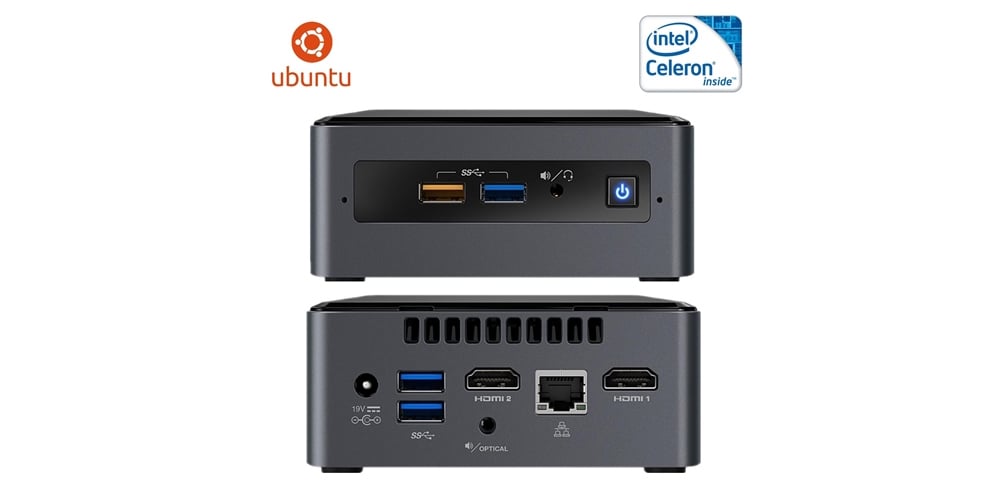
If you want to simply plug it in and start, this is the best option.
Comprehensive, full-featured CMS
There are free and open-source digital signage CMSs out there, as well as a lot of off-brand solutions doing content management duty for DIY rigs. But they’re not at the standard of a real digital signage CMS.
You should expect a CMS that does more than let you queue content up. Look for:
Scheduling
Your CMS should have complex scheduling, months in advance, meaning you can batch your signage content efforts.
Groups of screens
You should be able to group different screens and determine different content based on audience requirements.
Templates
You shouldn’t need to build your own content from scratch every time. Instead, large and ever-growing template libraries (ours stands at 325 and rising) let you build content quickly and easily. A powerful content editor lets you start with standard templates from our library and quickly adapt them to your branding, logo, and style.
Import and embed
Can you import content from third-party sources? The functionality to do this is missing from a lot of lower-end CMS-like tools. Rise Vision lets you import content from the most popular presentation-building software, including Google Sheets, and embed content from social media, RSS, YouTube and much more — including live streams, graphics and GIFs.
Setup is fast and simple
Setting up Rise Vision is fast and simple. You don’t need technical know-how or hours of time to figure out how to make it work.
Conclusion
DIY digital signage is alluring on first inspection. Lower costs, more control, and you can even use some of the equipment you already have. But it’s a false economy. That equipment isn’t built for the durability, compatibility and functionality you need. And content management, scheduling and display are best done using built-for-purpose, tried-and-tested software, not a McGyvered collection of tools that were really meant for something else.
Digital signage isn’t an add-on — younger audiences expect it, and engagement and efficacy stats show its power. When it’s crucial for reaching your audience, it needs to be up to the task; and DIY setups are much more likely to let you down.
If the cost of a professional, highly optimized digital signage solution is what’s stopping you from making the investment, there are subscription options where you can get everything you need to implement digital signage.
Our Avocor R Series Hardware as a Service is an all-in-one solution that comes with a display and built-in media player. Without requiring other external hardware, signing up for the Avocor R Series will help simplify your digital signage, eliminate upfront CAPEX costs, and get full hardware management and support from Rise Vision.
If you already have a display, put it to good use with our subscription media player. The Rise Vision Media Player Hardware as a Service gives you a powerful media player with a plug-and-play setup and high performance with the Rise Vision software. The media player is managed and supported by Rise Vision so you never have to worry about technical complexities and can focus on communicating your message.
Get started with one of our subscriptions by reaching out to us.


